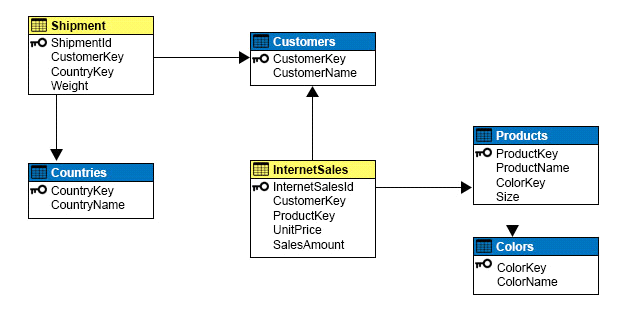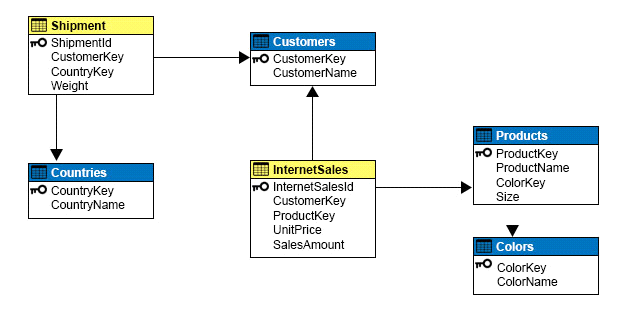Microsoft 70-768 Exam Questions
- Microsoft MCSA: SQL 2016 BI Development Certifications
- Microsoft MCSE: Data Management and Analytics Certifications
- Topic 1: Use Directquery With Oracle, Teradata, Excel, And Pivottables; Convert In-Memory Queries To Directquery Configure Tabular Model Storage And Data Refresh, Configure Refresh Interval Settings, Configure User Security And Permissions, Configure Row-Level Security
- Topic 2: Use The EVALUATE And CALCULATE Functions, Filter DAX Queries, Create Calculated Measures, Perform Data Analysis By Using DAX
- Topic 3: Design And Publish A Tabular Data Model/ Develop A Tabular Model To Access Data In Near Real Time
- Topic 4: Design, Develop, And Create Multidimensional Databases; Select A Storage Model/ Design And Implement Dimensions In A Cube
- Topic 5: Create Custom MDX Or Logical Solutions For Pre-Prepared Case Tasks Or Business Rules, Define A SCOPE Statement
- Topic 6: Create A Multidimensional Database By Using Microsoft SQL Server Analysis Services (SSAS) Configure Partition Processing; Configure Dimension Processing; Use Process Default, Process Full, Process Clear, Process Data, Process Add, Process Update, Process Index
- Topic 7: Process Structure, And Process Clear Structure Processing Methods; Configure Parallel, Sequential, And Writeback Processing Settings
- Topic 8: Implement Measures And Measure Groups In A Cube/ Create Formulas By Using The DAX Language/ Implement Custom MDX Solutions
- Topic 9: Monitor Performance And Analyze Query Plans By Using Extended Events And Profiler, Identify Bottlenecks In SSAS Queries
- Topic 10: Monitor Processing And Query Performance, Resolve Performance Issues, Configure Usability Limits, Optimize And Manage Model Design
- Topic 11: Select An Appropriate Dimension Model, Such As Fact, Parent-Child, Roleplaying, Reference, Data Mining, Many-To-Many, And Slowly Changing Dimension
- Topic 12: Implement A Dimension Type; Define Attribute Relationships/ Monitor And Optimize Performance/ Configure And Manage Processing Design Measures, Relationships, Hierarchies, Partitions, Perspectives, And Calculated Columns; Create A Time Table; Publish From Microsoft Visual Studio
- Topic 13: Import From Microsoft Powerpivot; Select A Deployment Option, Including Processing Option, Transactional Deployment, And Query Mode
Free Microsoft 70-768 Exam Actual Questions
Note: Premium Questions for 70-768 were last updated On 01-01-1970 (see below)
You need to configure the server to optimize the afternoon report generation based on the OrderAnalysis cube.
Which property should you configure?
LowMemoryLimit: For multidimensional instances, a lower threshold at which the server first begins releasing memory allocated to infrequently used objects.
From scenario: Reports that are generated based on data from the OrderAnalysis cube take more time to complete when they are generated in the afternoon each day. You examine the server and observe that it is under significant memory pressure.
You are responsible for installing new database server instances.
You must install Microsoft SQL Server Analysis Services (SSAS) to support deployment of the following projects. You develop both projects by using SQL Server Data Tools.
You need to install the appropriate services to support both projects.
Which two actions should you perform? Each correct answer presents part of the solution.
Analysis Services can be installed in one of three server modes: Multidimensional and Data Mining (default), Power Pivot for SharePoint, and Tabular.
References:https://docs.microsoft.com/en-us/sql/analysis-services/comparing-tabular-and-multidimensional-solutions-ssas
You are a business analyst for a retail company that uses a Microsoft SQL Server Analysis Services (SSAS) multidimensional database for reporting. The database contains the following objects:

You must create a report that shows, for each month, the Internet sales for that month and the total Internet sales for the calendar year up to and including the current month.
You create the following MDX statement (Line numbers are included for reference only.):

You need to complete the MDX statement to return data for the report.
Which MDX segment should you use in line 01?
The following example returns the sum of the Measures. [Order Quantity] member, aggregated over the first eight months of calendar year 2003 that are contained in the Date dimension, from the Adventure Works cube.
Copy
WITH MEMBER [Date].[Calendar].[First8Months2003] AS
Aggregate(
PeriodsToDate(
[Date].[Calendar].[Calendar Year],
[Date].[Calendar].[Month].[August 2003]
)
)
SELECT
[Date].[Calendar].[First8Months2003] ON COLUMNS,
[Product].[Category].Children ON ROWS
FROM
[Adventure Works]
WHERE
[Measures].[Order Quantity]
References:https://docs.microsoft.com/en-us/sql/mdx/aggregate-mdx
Note: This question is part of a series of questions that use the same or similar answer choices. An answer choice may be correct for more than one question in the series. Each question is independent of the other questions in this series. Information and details provided in a question apply only to that question.
You have a Microsoft SQL Server Analysis Services (SSAS) instance that is configured to use multidimensional mode. You create the following cube:

You need to create a new dimension that allows users to list shipments by the country where the product is shipped.
Which relationship type should you use between the Shipment table and the new dimension?
Many to Many Dimension Relationships.
In most dimensions, each fact joins to one and only one dimension member, and a single dimension member can be associated with multiple facts. In relational database terminology, this is referred to as a one-to-many relationship. However, it is frequently useful to join a single fact to multiple dimension members. For example, a bank customer might have multiple accounts (checking, saving, credit card, and investment accounts), and an account can also have joint or multiple owners. The Customer dimension constructed from such relationships would then have multiple members that relate to a single account transaction.
References:https://docs.microsoft.com/en-us/sql/analysis-services/multidimensional-models-olap-logical-cube-objects/dimension-relationships
Note: This question is part of a series of questions that use the same or similar answer choices. An answer choice may be correct for more than one question in the series. Each question is independent of the other questions in this series. Information and details provided in a question apply only to that question.
You have a Microsoft SQL Server Analysis Services (SSAS) instance that is configured to use multidimensional mode. You create the following cube:

Users need to be able to analyze sales by color.
You need to create a dimension that contains all of the colors for products sold by the company.
Which relationship type should you use between the InternetSales table and the new dimension?
A regular dimension relationship between a cube dimension and a measure group exists when the key column for the dimension is joined directly to the fact table.
- Select Question Types you want
- Set your Desired Pass Percentage
- Allocate Time (Hours : Minutes)
- Create Multiple Practice tests with Limited Questions
- Customer Support
Currently there are no comments in this discussion, be the first to comment!